
So glad I found out you can quite easily make these yourself!
I used to buy ciappe and always liked them as a lovely way to cure a craving for something salty or when on the run.
For some reason beyond my comprehension it did not sink in to make them myself. Which is strange because ‘what’s in it and can I make it myself’ is usually my first though when encountering something new.
Anyway, reading the ingredients list of the shop bought ciappe and using some baking experience I came up with this recipe. Because leafing through my baking books and browsing the web I did not find much information on recipes, origins and methods of the ciappe. Maybe I did not look in the right places, but I am glad the recipe turned out as it did. Let me know what you think…
I read somewhere that in Ligurian dialect ‘ciappa’ means a flat and thin stone
I have a few remarks before you start. In this recipe I use fresh rosemary. I have to say that after baking the taste of the rosemary is rather faint. For a more pronounced taste you can infuse the olive oil with the rosemary some time in advance or you can use dried rosemary instead. With this recipe you get 12 big crackers. We have to use 3 baking trays (48×48 cm) to accommodate them all, so keep this in mind. You might not be able to bake them all in one go in your oven.
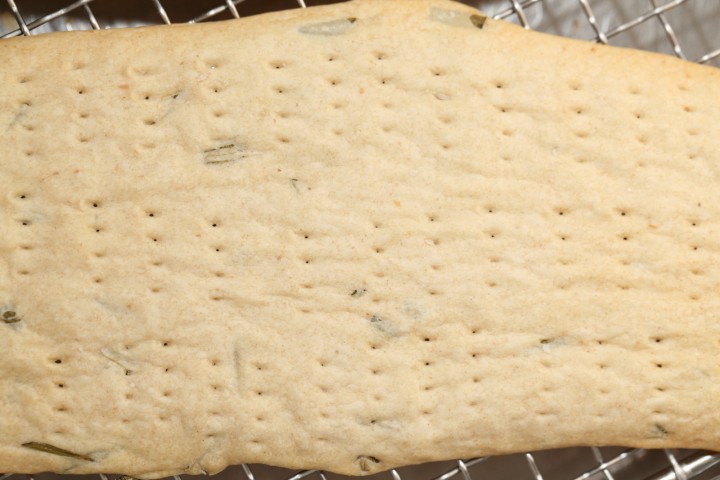
Ingredients for the Ciappe
500 g fine wheat flour / Italian 00
250 g water
50 g olive oil
8 g salt
4 sprigs of fresh rosemary, chopped
coarse sea salt for sprinkling
Making the Ciappe
Preheat your oven at 150ºC / 300ºF convection setting (hot air).
In a bowl, combine all the ingredients and knead by hand for 1 minute until you have a uniform dough. Make sure not to over-knead, you want crispy crackers, so very little gluten development.
Divide the dough into 12 little balls, about 68 g per ball. Take a ball, push it into a flat disc with your hand and, with a rolling pin, roll it out to a very thin oblong shape (about 1 mm).
Place the ciappe on a baking tray. Now with a fork, make little holes all over the surface. Sprinkle some coarse salt on the dough. Now on to the next ball, repeating the process.
Bake in the preheated oven for 20 minutes (depending on your oven) until very light golden in color. Leave on a rack to cool completely.
Place the ciappe in an airtight container. Well sealed they can stay crunchy for a week or so. You can also store them in the freezer where they will keep for several weeks.
As a variation on a theme (maybe not always authentic but also very good) try making them with olives, caraway or cumin seeds or replace (some of) the wheat flour with spelt.



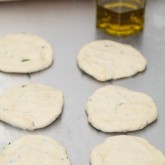


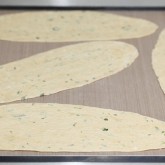



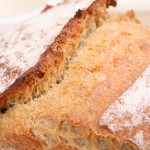

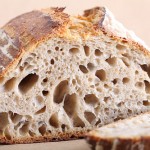

Jennifer says
I’ve been searching for a recipe like this! Thank you!
I pressed thinly cut slices of green onions on top and they turned out deliciously.
Weekend Bakers says
Thank you for also sharing your tasty suggestion with us Jennifer. We have never tried this with green onions before, but are already sure it will be a great flavor combination.
Sue says
Many thanks for the recipe for the flat bread. Wonderful!! Tastes amazing!!
Philip says
I blitz the rosemary in the water and strain it so you get the rosemary taste without the bits that can tear the dough in the pasta roller. I also add a smallish amount of sourdough starter and ground black pepper.
Groh says
Great idea
elly rietveld says
super eindelijk een goed recept voor ciappe!
dank hiervoor
Weekend Bakers says
Dankjewel Elly,
Mocht je een pastamachine hebben, dan gaat het rollen daarmee echt perfect.
Dank en veel plezier met het recept!
Marieke
Rajh says
Super
Eva says
Thank you for the recipe! Made these with my youngest son to accompany the christmas dinner starters. Had a blast making them, with the pasta machine.
And they were a hit!
Kind regards,
Eva, Rotterdam, the Netherlands
Weekend Bakers says
Hello Eva,
So happy to read your comment. Yes, the pasta machine does the job very well. Doesn’t get any better than baking with the next generation. Glad to be a small part this way of your Christmas happiness. Wishing you and your loved ones a very happy and healthy New Year and enjoyable moments these last days of 2018.
Tessa says
I made these today and I love them! I’d never had ciappe before so I don’t have any kind of reference, but I used about one tablespoon of dried rosemary and that seems like a good amount to me. As someone who is quite new to savory baking, I do wonder though – what does the olive oil do for the crackers? Is it only for flavour or does it create a different texture compared to when you’d replace it with just another 50 ml of water?
Weekend Bakers says
Hello Tessa,
Thank you very much for your friendly comment. In this case the olive oil contributes fat but no leavening of the baked crackers. Oil is 100% fat and does not contain water or trapped air to promote leavening. It contributes flavor (and color) and also aids with the spreading of the dough. Combining the olive oil with the rosemary also means the taste of the rosemary partly dissolves in the oil, also making the crackers richer in flavor.
Wishing you a happy baking weekend!
Lesley Hofmann says
Thank you so much yet again. I have finally made tender delicious crackers. Always used bread flour before and the results were ALWAYS tough. The rosemary and olive oil are an absolute winner!
Weekend Bakers says
Hi Lesley,
Thank you so much for your enthusiastic feedback. Very happy this recipe works for you too. We love them and the taste of the rosemary picked from the garden.
Happy baking from Holland,
Marieke
Michelle Becker says
If I were to use the pasta machine to roll out the dough what would be the most suitable thickness setting, 1 being the thickest and 7 being the thinnest on my machine. I use 6 for lasagne. Thanks in advance for your response.
Weekend Bakers says
Hello Michelle,
We think setting 5 or 6 would also be the right one for these crackers and would be close to what we use on our own machine. If you get them nice and thin (around the 1 mm mark) they will be crisp and stay that way for many days.
Hope you’ll enjoy them!
Kay says
Hi there. Just made this and it’s good. Thanks. Just wondering if you have tried a leavening agent either yeast or baking powder to get a little bit of loft? Just wondering as I find them a bit on the heavy side from my memory of ciappe. Your thoughts?
Weekend Bakers says
Hi Kay,
Yes, that would be something to try for sure. It could very well work. We specifically wanted a recipe without yeast, and for us the result, with the thin crispness is very nice, but no harm in trying a version with yeast (we prefer yeast over baking powder because of the fermenting of the flour).
Let us know if you do give it a try!
Helena says
Thanks for this recipe.
I have done it using some discards.
300 g starter
350 g flour
100 g water
It gave the Ciappe a gorgeous sour taste!
Cheers
Weekend Bakers says
Such an excellent idea Helena! Thank you for sharing.
BC says
Nice!
Devin Dunseith says
This website has been an absolute saviour! I’ve been wanting to find some more exciting bread recipes, and yours are amazing! I’ve just made some of these Ciappe’s, and they are so easy and so tasty (especially when dipped in my homemade smoky paprika houmous), I’ll definitely be trying them again (and the cayenne recipe sounds exciting too)! Thanks, and keep the great recipes coming 🙂
Weekend Bakers says
Hello Devin,
Glad you like the recipe. Your houmous sounds like a great accompaniment to the ciappe.
An extra tip: if you have a pasta machine you can use it to roll the ciappe dough to a perfect thin shape, I think it works even better than a rolling pin.
Happy baking,
Marieke
thelittleloaf says
Great minds – I made something really similar last night, but instead of rosemary used a pinch of cayenne pepper and paprika! Was absolutely delicious and will definitely try this Italian version soon.
Weekend Bakers says
O, that is not a coincidence maybe ;). I do love the idea of hints of cayenne!
BC says
Yes! In the oven as we speak!
Is your dough really stiff?
Weekend Bakers says
Hi BC,
The dough is not especially stiff, but it is very manageable, soft but not wet and sticky. The idea is to roll out the dough very, very thin so it will become very crisp in the oven, like a cracker should be.